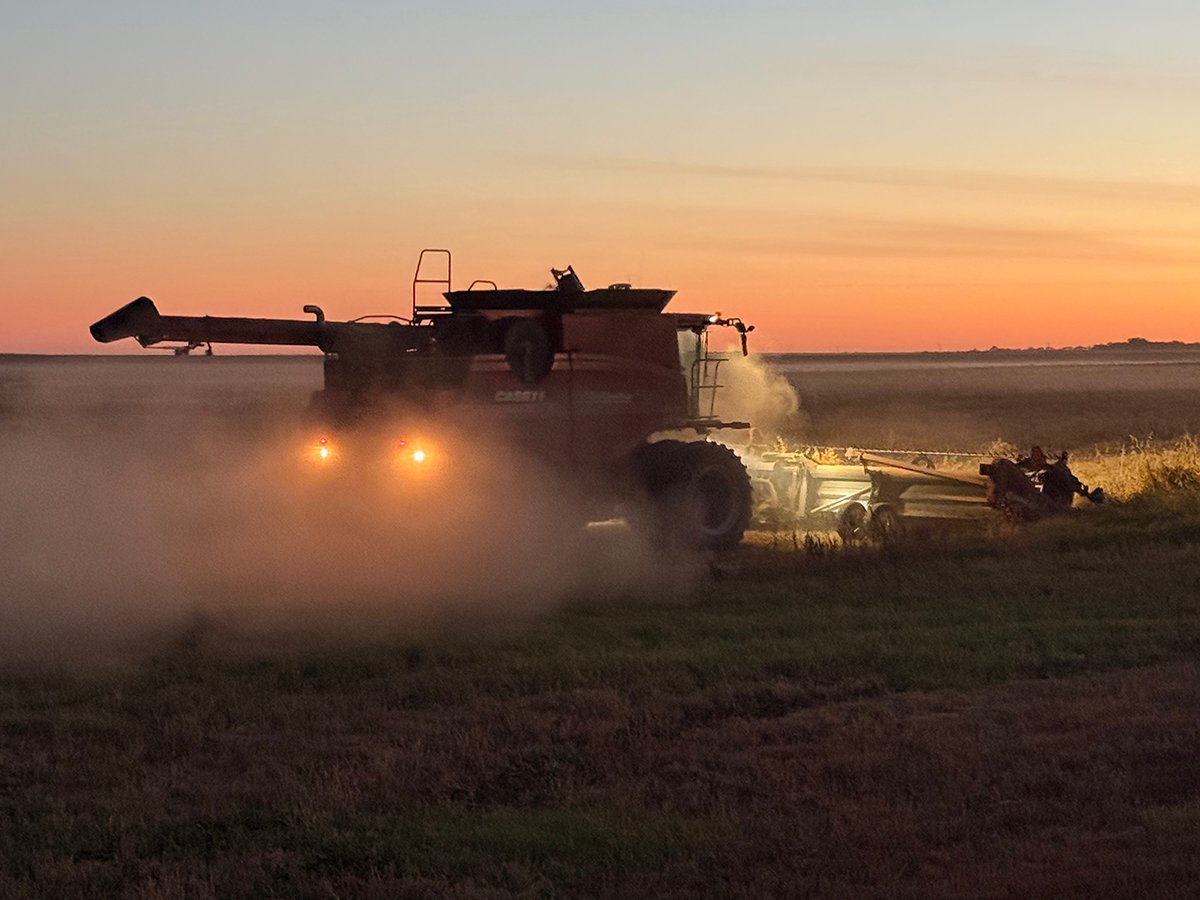Type right
Every child given access to a computer should be taught how to sit and how to position his hands on the keyboard. Otherwise the child’s future may hold chiropractic treatments and the pain of carpal tunnel syndrome.
Before computers became as common as Visa cards, unless you hobnobbed with tennis players you rarely heard of carpal tunnel syndrome. Now it’s an everyday complaint, lumped in with other repetitive stress injuries resulting from robot-like movements throughout a shift.
But proper posture thwarts the ailment. As proof, a professional pianist, interviewed on CBC radio, revealed he had undergone three years of therapeutic posture training to improve his body balance as a way to alleviate his carpal tunnel syndrome discomfort.
Read Also

Downturn in grain farm economics threatens to be long term
We might look back at this fall as the turning point in grain farm economics — the point where making money became really difficult.
Why not ward off the ailment by teaching kids proper keyboard posture? Watch computer operators in classrooms, on the job, in movies and news clips.
They slouch, legs entwined around their chair legs, wrists Crazy-Glued to the computer frame. Only their fingertips move, like elephant trunks searching blindly over a concrete barrier for a peanut. No wonder their wrists throb.
I learned typing from a correspondence course in Grade 9. Each day’s lesson began with the same reminder: sit up straight, feet flat on the floor, one foot in front of the other. Curl fingers over the keyboard; hold hands, wrists and forearms in a line….
Over 14 years as a medical secretary I typed many a seven-hour shift without physical discomfort, all before photocopiers and electric typewriters. Often I typed eight copies. Only a powerful touch would make all copies legible.
Yet at age 66 I’ve yet to feel a hint of carpal tunnel syndrome.
A computer in every home and classroom is fine – if kids are reminded daily how they should sit, and how their wrists should be held up. Don’t handicap their potential by faulty keyboard habits, habits difficult to treat or retrain away years later.
– Claudette Sandecki,
Terrace, B.C.
Support helmets
It was interesting to read 4-H member Amanda Crashley’s letter of Nov. 1 in the Western Producer on helmet use by their riders. I find the comments that were made by the judge at a district competition the club attended absolutely appalling.
He apparently stated that “safety is important, but when you are an experienced rider you shouldn’t have to wear a helmet.”
It is hard to believe that any experienced, long-time horse person would make a statement of such ignorance.
I speak from personal experience in saying that a regulation equestrian helmet is an invaluable part of a rider’s equipment and should be worn every time you ride.
Having ridden many different types of horses over a 40-year period, I believe I would fall into the category of an experienced rider. My helmet has now saved me from serious head injury or worse several times.
Yes, a couple of falls resulted from being on an unpredictable horse, but when it comes down to it, any horse can be unpredictable in an unforeseen circumstance as they are creatures of flight and not reason.
The most recent mishap occurred this past summer when I was on my older, very seasoned trail horse. We were just trotting along when he tripped, his knee buckled and I was thrown halfway up his neck and could not regain my seat. He panicked and spun around several times until I was thrown off and landed on my back and heard the back of my helmet give a cracking noise. If I had not had it on, that would have been my head.
So there you have it. Experienced horse, experienced rider, but that does not give you immunity to accidents.
Even though their club was penalized for not being in “proper western attire,” I applaud them in not letting such criticisms affect their stand on helmet use.
For that matter, hats are now available for western riders with helmet protection, as well as the English style helmets.
– Carol Leite,
North Battleford, Sask.
Answers wanted
Chairman Ken Ritter claims the issue of costs and accountability to farmers is taken seriously by the Canadian Wheat Board directors in the “Cutting costs” article (WP, Oct. 18.)
If that’s the case, they have a lot of public explaining to do.
Prairie farmers, there is no government-mandated monopoly on your grain. The monopoly is imposed by a self-serving bureaucracy in Winnipeg.
The CWB grants licences whenever, and to whomever, they please. Licence granted – you’re out of the monopoly. Licence denied – you can only sell to the CWB. It’s that simple.
But it gets worse. The farmers who are denied the licences pay the costs for the privileged who are granted the licences.
And even more remarkable, according to the CWB Act, these licensing costs should be paid by the government instead of prairie farmers.
The reality is that there is no legislated requirement for accountability to farmers, which allows biased directors to favour the CWB over the interests of farmers. However, there is a requirement of accountability to Parliament. They must follow the legislation.
Chairman Ritter has already admitted to Parliament that they are unsure of their legislation. This CWB confusion is costing prairie farmers money. We need honest answers. If the directors don’t have the answers, they have a duty to find out.
– John Husband,
Wawota, Sask.
Too far
It seems that PETA (People for the Ethical Treatment of Animals) has been taken over by fanatics who will do anything to get their anti-meat, anti-milk message out, even if it means terrorizing school children. This group has lost all credibility.
PETA claims that milk causes obesity. Yet obesity has increased across the United States and Canada as milk consumption has dropped. Weight problems are clearly linked to the consumption of low-nutrient foods (junk food). It’s absurd to blame milk.
PETA claims that milk causes heart disease and stroke. Yet the studies show that milk actually protects against vascular diseases. Milk lowers blood pressure and all other risk factors. The more milk in the diet, the lower the risk of disease.
PETA insists that milk causes several types of cancer. This claim is based on a number of studies that have associated defatted milk (skim milk, no-fat yogurt) with an increased risk for prostate cancer.
Whole-fat milk, however, has never been linked to cancer of any kind. Quite the opposite. Whole-fat dairy foods have been found to protect against cancer, particularly breast cancer.
PETA claims that milk causes osteoporosis. This claim is based on the fact that very high levels of protein in the diet can cause a loss of calcium.
But milk is not excessively high in protein, and thus the amount of calcium that might be lost is very small – no more than eight percent. Milk is an excellent source of calcium.
Milk does not cause pimples, gas or “excess mucus” either. These claims have no validity whatsoever.
The PETA members targeting school children should be regarded as dangerous extremists and dealt with accordingly. They’ve carried their cause much too far.
– Thomas Anderson,
Health Sciences
Research Institute,
Summerland, B.C.
Great cartoon
Recently our household received a free copy of The Western Producer in our mailbox, and while not being actual producers, enjoyed the articles, columns and comments in your paper.
I found the most noteworthy part of your paper to be the cartoon on page six.
The depiction of an elderly veteran standing at attention, saluting the cenotaph and memories of brothers lost is undoubtedly one of the most touching scenes representing Remembrance Day that I have ever had the pleasure of viewing.
I had the opportunity of explaining my feelings toward the picture to my 12-year-old daughter, whereby, I believe, giving her far more depth as to the day and just how lucky we all are.
I am a 42-year-old father of four, and although not a veteran, feel the loss they must all feel, through this picture. It is my wish to always remember, and to see that my children carry this into their families and futures.
Craig, from the depths of my heart and on behalf of veterans everywhere, thank you.
– Tom Lander,
Barrhead, Alta.
Simple labels
The Women’s Institute of Alberta, as I am sure institutes of other provinces, are very concerned about genetically modified foods.
Through studies, resolutions have been put forth to various government agencies requesting labelling of such foods. Replies have not indicated that the Canadian government is willing to do this, but rather, have suggested companies voluntarily provide such labelling.
As one panelist at the Alberta WI convention in 2000 stated, the packaging would have to be very large in order to list all the ingredients, and costs would rise. Does this give us cause for concern? I think so.
As has been stated by others in The Western Producer, it is already too late to prevent genetic modification. If that is so, then my suggestion would be that to protect ourselves, we should be requesting each package that has GM ingredients could have a simple GM circled on the package which would alert us to seek more information.
Since companies have no trouble putting out tear-off sheets for recipes, etc., it should be simple to produce tear-off sheets with the ingredients listed. Then, for those who are concerned, they could at least have the information available.
Sometimes we try too hard to find a solution when such a simple idea might solve the problem. Worth considering?
– Alice Lowis,
Bashaw, Alta.
Trains & grain
It is with some interest that the paper of Oct. 25 had a story about the Railroad Alliance plans to run services on some CN railroads, should some funding come from the province toward its success.
The accompanying map showed the areas that may see this service. Since I live in the northeast and have witnessed the emasculation of both lines and elevators, I view this exercise almost like the farmer whose 20-cow cattle herd had somehow managed to force open a gate and 15 of them got away before the farmer noticed and managed to shut the gate to at least save the five remaining.
It would be great to see the Tisdale-Hudson Bay line reactivated again like the map illustrated and then west of Melfort to Prince Albert. However, it is my understanding that the portion from Birch Hills is serviced by Carlton Trail, which would like to have a link to Omnitrax to Churchill.
Puzzling me is a line from Tisdale to Nipawin, which of course is CPR and that it does not end at Nipawin but terminates in Choiceland, a point from which the (Saskatchewan Wheat) Pool has woefully retreated and left farmers no choice but to load producer cars.
Surely the map should have included that portion, if indeed CP is in on this deal as well.
Perhaps this process could even see the reactivation of some sound wooden elevators that may not have been sold yet, given favourable freight rates or the construction of suitable car-loading facilities at some key points along the way.
I have never been a proponent of large concretes, a rationalization scheme invented by idiots that has destroyed hundreds of small towns, contributed to thousands of farmers leaving the farms and did nothing to the bottom lines of those few still around.
In fact, it is much worse today, not only for farmers but for many rural business people.
Some people that are clamouring for intense highway rebuilding budgets should have their heads examined and fill that void in a crash course of simple economics and social interactiveness within our immediate human fabric.
– Harry Beskorovayny,
Gronlid, Sask.
No protection
The main reason investment from the major financial players has not been realized in the hog industry is because of the susceptibility to massive liability lawsuits that could appear from environmental contaminations.
I personally have confirmation when requested of Saskatchewan Government Insurance when asked whether they would provide liability protection to farmers allowing liquid hog sewage onto their property. The answer, in writing, from SGI was no liability protection would be provided.
If insurance companies are not willing to provide liability insurance, I believe you have an example by this action as to why investment is so low in the industry.
– George Choboter,
Buchanan, Sask.
















